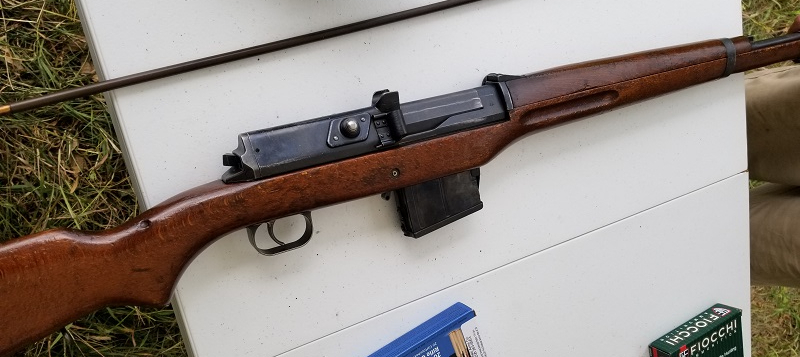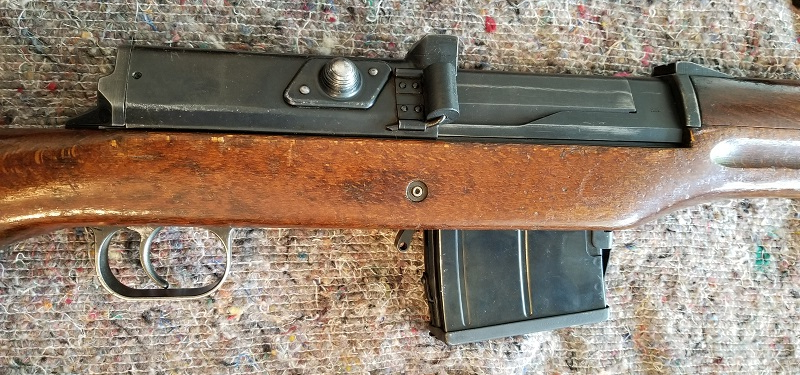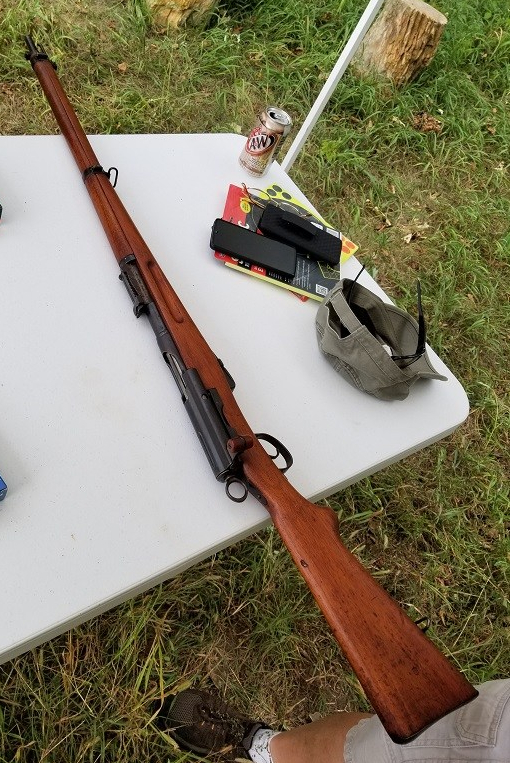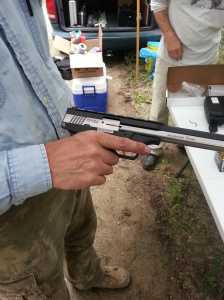The Fightin’ Swedes/Swiss.
Two last battle rifles today: the Swedish Ag m/42B in 6.5×55 and the Swiss Schmidt-Rubin Model 1911 rifle.

Swedish Automatgevär m/42
We should have done our homework on this.
Why? Because we had no idea about how to operate it. I’ll save you the several videos of us fumbling with it, trying to figure out what the hell made the thing work. Instead, go watch this video of how the mechanism works, if you’re interested.
At least none of us mashed our thumbs, which even Ian at Forgotten Weapons was nervous about (watch his second video there).
Anyway, the Swedish AG m/42B is a direct gas-impingement self-loading rifle introduced in 1942. It’s a little odd in design, but makes sense once you understand it (which I really didn’t until I did research for this post). And it’s fairly simple and robust, so was able to stay in use until the 1960s. Here are a couple of additional images of it:

Swedish Automatgevär m/42B

Swedish Automatgevär m/42B
Those odd knob things? That’s the dust cover/bolt carrier, and it’s how you operate the loading mechanism safely. Go watch the video above — trying to explain it is … complicated.
Note the simple range adjustment dial for the sight there on the left (bottom) in front of the receiver. Nice, easy to use. Because that’s one of the great things about this rifle — the 6.5×55 Swedish cartridge is a very flat-shooting round, and the rifle has an effective range out to 800 meters. The rifle is also relatively heavy, so that combined with a simple integrated muzzle break means that it has very light recoil. See for yourself:
This was really a pleasure to shoot, and while I’m not into rifles that much, I could easily see myself having one of these guns.
Schmidt-Rubin Model 1911 rifle

Model 1911
The Schmidt-Rubin was a heavy battle rifle, designed for the long tradition of Swiss sharpshooting. As part of a series of rifles beginning with the Model 1889, the Model 1911 entered service in 1911 (surprise!). Firing a new more powerful cartridge (7.5×55) than the previous models, it had an aimed range out to 600 meters, and a volley range to 2000 meters. It has a straight-pull bolt action (no need to rotate the bolt to unlock it) which is slick and fast.

Schmidt-Rubin Model 1911
It’s easy to operate, easy to shoot well. It was also famously accurate, and is still valued as both a hunting and long distance target rifle. With a 175gr bullet at 2650fps out of the long 30″ barrel generating about 2700ft/lbs of energy, it is perfectly suitable for either. Since the Model 1911 weighs about ten pounds, recoil is modest.
As I’ve said several times with these historic rifle reviews, if you get a chance to shoot either the Swiss Schmidt-Rubin or the Swedish Ag m/42B, do so.
But if it’s the Ag? Watch your thumbs.
Jim Downey
Six shooter.
Well, well, well, BBTI made it to six years of shooting fun and research!
Yup, six years ago today we posted the first iteration of Ballistics By The Inch, and included data for 13 different handgun cartridges. Since then we’ve continued to expand on that original research, including some extensive testing on how much of an effect the cylinder gap on revolvers has, what performance differences you can expect from polygonal over traditional land & groove rifling, and added another 9 cartridges, as well as going back and including a very large selection of real world guns in all the different cartridges. This blog has had 100,000+ visitors and the BBTI site itself has had something like 25 – 30 million visits (the number is vague because of changes in hosting and record-keeping over time).
We’ve had an impact. I’ve seen incoming links from all around the world, in languages I didn’t even recognize. There’s probably not a single firearms discussion group/blog/site out there which hasn’t mentioned us at some point, and our data is regularly cited in discussions about the trade-offs you make in selecting one cartridge or barrel length over another. I’ve answered countless emails asking about specific points in our data, and have been warmly thanked in return for the work we’ve done. And on more than a few occasions people have pointed out corrections which need to be made, or offered suggestions on how we could improve the site, sometimes providing the results from their own crunching of our data.
When we started, it was fairly unusual to see much solid information on ammo boxes about how the ammunition performed in actual testing. Now that information is common, and expected. Manufacturer websites regularly specify real performance data along with what kind of gun was used for that testing. And the data provided has gotten a lot more … reliable, let’s say. We’ve been contacted by both ammo and firearms manufacturers, who have asked if they can link to our data to support their claims of performance — the answer is always “yes” so long as they make it clear that our data is public and not an endorsement of their product. And we’ve never taken a dime from any of those companies, so we can keep our data unbiased.
And we’re not done. We have specific plans in the works to test at least one more new cartridge (and possibly revisit an old favorite) in 2015. I try to regularly post to the blog additional informal research, as well as sharing some fun shooting and firearms trials/reviews. There’s already been one firearms-related patent issued to a member of the BBTI team, and we’ll likely see several more to come. Because we’re curious guys, and want to share our discoveries and ideas with the world.
So, onward and upward, as the saying goes. Thanks to all who have cited us, written about us, told their friends about us. Thanks to all who have taken the time to write with questions and suggestions. And thanks to all who have donated to help offset the ongoing costs of hosting and testing — it makes a difference, and is appreciated.
Jim Downey
And now for some newer guns.
Last week I posted about some historical reproductions. Now let’s have a quick overview of some newer guns we got to try on the same trip to the range. I’ll include some *very* brief comments, and may return to do longer reviews later when I have some additional time.
First up, the USFA ZiP .22LR, shown with 25-round mag for additional grip purchase:

Comments: Ugh. I hated this gun. Seriously. It’s awkward to hold, worse to shoot, all sharp angles and weirdly thick. It’s the kind of ugly that isn’t even interesting. The design requires you to put your hand right up close to the muzzle to cycle the action. Since it was brand new, I’ll forgive it having problems cycling properly (this is fairly common with rim-fire guns which are brand new), but I sure as hell wouldn’t want to have to shoot it enough to break it in.
Bottom line: if someone insisted on giving me one of these, I’d just turn around and sell it to use the money for almost any other purpose.
Next, the Excel Arms MP-22 .22mag Accelerator:
Comments: Nice gun. Shot very well, and the 8.5″ barrel is sufficiently long to get some benefit out of the .22WMR cartridge. The heavy bull barrel also does a good job of taming the recoil and muzzle-flip, as can be seen in this vid:
Next, the SIG 232 .380acp:
Comments: SIG SAUER’s version of the classic PPK. Just what you’d expect: quality, accurate, easy to shoot for even someone with large hands, as can be seen in this image of my buddy who has even larger hands than I do:
Next, the Glock 42 .380acp:
Comments: I did not expect to like this gun. I was REALLY surprised when I did. Seriously, it is the best-shooting Glock I’ve ever handled. For such a small gun, it fit my large hands comfortably and was easy to shoot well. With Glock quality and reliability, this may be the first .380acp I would seriously consider as a CCW gun.
Next, the Kimber Solo Carry 9mm:
And here’s a vid of shooting it:
Comments: Kimber quality. Lot of power in a small package, and I felt it in the web between thumb and forefinger of my dominant hand. But that was just a sting, not uncomfortable, even shooting premium SD ammo. Another good candidate for CCW.
And here’s a quick look at an old classic: Winchester Model 70 XTR Featherweight in 6.5 Swedish (6.5mm x 55mm)
Comments: Like I said, a classic. And as such, a known quantity. But the first time I’ve shot one in 6.5 Swede, and I was pleasantly surprised by how little recoil there was.
Well, that’s all that I have images of, though we also shot a Chiappa M1-22 and a KelTec PMR-30 .22 mag. Again, both are known quantities and shot as expected. Oh, and my buddy gave my Steyr S9 a go, and you can see that vid here.
As noted, I may revisit any of these with a longer review sometime later, but don’t hold your breath.
Jim Downey
-
Archives
- April 2024 (1)
- March 2024 (1)
- May 2023 (4)
- April 2023 (1)
- August 2022 (1)
- July 2022 (3)
- May 2021 (1)
- March 2021 (1)
- December 2020 (1)
- September 2020 (4)
- August 2020 (10)
- July 2020 (1)
-
Categories
- .22
- .223
- .22WMR
- .25 ACP
- .30 carbine
- .32 ACP
- .32 H&R
- .327 Federal Magnum
- .357 Magnum
- .357 SIG
- .38 Special
- .380 ACP
- .40 S&W
- .41 Magnum
- .44 Magnum
- .44 Special
- .45 ACP
- .45 Colt
- .45 Super
- .450 SMC
- .460 Rowland
- 10mm
- 6.5 Swedish
- 9mm Luger (9×19)
- 9mm Mak
- 9mm Ultra
- Anecdotes
- black powder
- Boberg Arms
- Data
- Discussion.
- General Procedures
- historic rifles
- Links
- Revolver
- Shotgun ballistics
- Uncategorized
-
RSS
Entries RSS
Comments RSS





